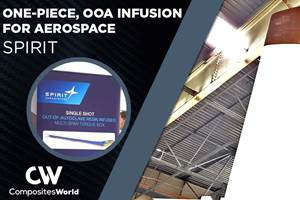Benzoxazine: An alternative to phenolic for interior fire safety?
As research into benzoxazine resin chemistry proceeds, this budding high-performance system has the potential to challenge phenolic resins in aircraft interiors.
As research into benzoxazine resin chemistry proceeds, this budding high-performance system has the potential to challenge phenolic resins in aircraft interiors. Proponents claim it offers the fire-safety of phenolic resin without its void content and other processing challenges. Although some users caution that benzoxazine has not yet attained the maturity of bismaleimide (BMI) and still requires development in several areas, including out-of-autoclave (OOA) processing, Matrix Composites (Rockledge, Fla.) president Dave Nesbitt sees a future for benzoxazine applications in the interiors of aircraft and other modes of transportation, especially using resin transfer molding (RTM).
“It’s better suited to closed-molding applications compared to phenolic,” Nesbitt claims. “As a result, we can now offer the benefits of highly integrated structures to applications previously limited to conventional autoclave-cured phenolics. It’s another tool in our tool chest, and new systems like this enable us to offer optimized solutions to our customers.”
Resin supplier Huntsman Advanced Materials’ (Basel, Switzerland and The Woodlands, Texas) composites marketing manager, Carl Holt also contends that “benzoxazine has better fire, smoke and toxicity (FST) properties than epoxies.” The resin reportedly has very good heat-release rates, can meet OSU 65/65 (a fire safety standard established by Ohio State University), has low burn times (a short time before self-extinguish) and exhibits very benign smoke toxicity and low smoke density. “No solvent is needed for prepregs, for example, and benzoxazine produces void-free laminates very well using RTM,” he adds, noting that in RTM, it could be the easiest to use because, he claims, “phenolic generates too much water to use with that process.”
David Leach, global composites segment manager for Henkel Aerospace (Bay Point, Calif.), points to other factors. “Phenolics,” he reports, “release formaldehyde when they cure. Without proper precautions, this “causes environmental and health safety issues, and the volatiles cause porosity, which requires rework.” Henkel also believes that using benzoxazine prepreg could eliminate the postsecondary operations currently required when the finished surface quality of phenolic composites is an issue.
Gurit (Isle of Wight, U.K.) launched its PB1000 benzoxazine prepreg for interiors in 2008. Product development manager Paul Spencer explains, “We produce a lot of phenolic prepreg and began looking at next-generation materials that would match phenolic performance but be easier to manufacture, giving us flexibility at production sites, worldwide. We were also looking for customer processing improvements.” PB1000 was originally targeted for rail and aerospace, but FST regulations for rail vary by country and only underground or tunnel trains must meet more stringent requirements, similar to aerospace but still not quite as high. “We had several structural materials for aerospace and wanted to build on that capability.”
“Phenolic is very cheap,” Spencer admits, “so we are looking at more structural applications, where halogenated epoxy is no longer acceptable, or where improved handling and processing over phenolics is required.” He contends that benzoxazine’s reported cheaper prepregging and increased part surface quality could help offset its higher cost. “For example, reworking accounted for up to 60 percent of the cost for phenolic composite panels in rail interiors,” he contends. Although PB1000 has earned no commercial applications yet, qualifications are beginning with several manufacturers.
Related Content
Novel composite technology replaces welded joints in tubular structures
The Tree Composites TC-joint replaces traditional welding in jacket foundations for offshore wind turbine generator applications, advancing the world’s quest for fast, sustainable energy deployment.
Read MoreCOMPINNOV TP2 project promotes use of thermoplastics in aerospace
Completed in 2023, COMPINNOV TP2 explored thermoplastic composites, enhancing the understanding between prepregs and production methods to foster the potential for French aerospace innovation.
Read MoreCompPair adds swift prepreg line to HealTech Standard product family
The HealTech Standard product family from CompPair has been expanded with the addition of CS02, a swift prepreg line.
Read MoreVIDEO: One-Piece, OOA Infusion for Aerospace Composites
Tier-1 aerostructures manufacturer Spirit AeroSystems developed an out-of-autoclave (OOA), one-shot resin infusion process to reduce weight, labor and fasteners for a multi-spar aircraft torque box.
Read MoreRead Next
Plant tour: Daher Shap’in TechCenter and composites production plant, Saint-Aignan-de-Grandlieu, France
Co-located R&D and production advance OOA thermosets, thermoplastics, welding, recycling and digital technologies for faster processing and certification of lighter, more sustainable composites.
Read MoreAll-recycled, needle-punched nonwoven CFRP slashes carbon footprint of Formula 2 seat
Dallara and Tenowo collaborate to produce a race-ready Formula 2 seat using recycled carbon fiber, reducing CO2 emissions by 97.5% compared to virgin materials.
Read MoreVIDEO: High-volume processing for fiberglass components
Cannon Ergos, a company specializing in high-ton presses and equipment for composites fabrication and plastics processing, displayed automotive and industrial components at CAMX 2024.
Read More















.jpg;maxWidth=300;quality=90)









